Congratulations on deciding to start learning the piano. You are about to start your musical journey. I can sense that your excitement is reaching the sky. By now, you may have read numerous articles online about how to start the journey of learning.
One thing that all these sites will tell you is to learn the basic piano chords first. So, what's all the fuss about? And what are piano chords in the first place?
What is a Chord in Piano?
I guess you have seen how laying brick by brick creates a beautiful house. Well, if you imagine the house as a composition, then the bricks are the chords. Before getting directly into chords, we have to understand what a note is.
A note is a symbol or identification that denotes a particular musical sound. According to music theory, it can also represent the |
According to music theory, it can also represent the duration and pitch of a sound. Notes can also represent pitch classes. If you know about piano notes, it will be easier for you to understand what a chord is.
A chord is the combination of two or more piano notes played together. Yeah, it's that simple. Go and sit in front of the piano and strike three keys randomly; congratulations, you have played a chord. All the piano chords come with a root note, a third, and a fifth. A chord is named after the name of the root note; for example, chord A major (A) goes in this formation of A - C# - E. |
Yeah, it's that simple. Go and sit in front of the piano and strike three keys randomly; congratulations, you have played a chord. All the piano chords come with a root note, a third, and a fifth.
A chord is named after the name of the root note; for example, chord A major (A) goes in this formation of A - C# - E. You should know this: The most common type of piano chord is a three-note chord.
However, advanced chords usually involve four or more notes. Learn what is Whole Rest & Half Rest and its relation to Piano Notes Read
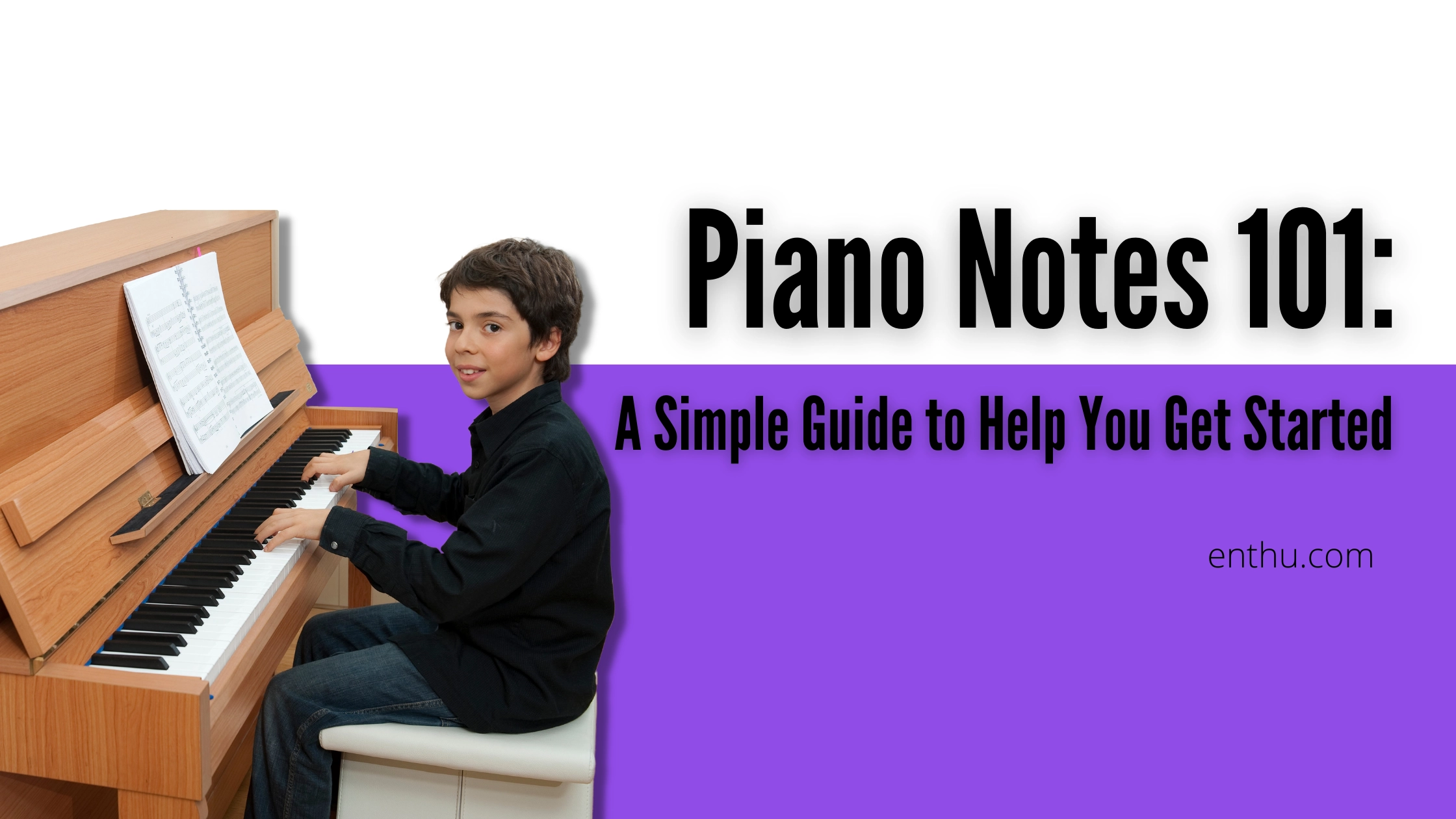
What are the Basic Piano Chords?
There are 12 basic piano chords that you must learn as a beginner. Without learning them, it's almost impossible to play the piano.
1. The 12 basic piano chords are
A major: A - C# - E
A minor: A - C - E
C major: C - E - G
C minor: C - Eb - G
D major: D - F# - A
D minor: D - F - A
E major: E - G# - B
E minor: E - G - B
F major: F - A - C
F minor: F - Ab - C
G major: G - B - D
G minor: G - Bb - D
Keep in mind that above chords are most popular piano chords, and it's not a serialized list of all the piano chords. Now, let's try to understand them. As I have mentioned above, all the piano chords are triads of piano notes. In other words, three notes come together to form a piano chord, and each note has a name.
The first note is called a root note, the middle note of the triad is the third, and the last note is called the fifth. To understand why it's the third and the fifth note, you need know how to make piano chords. But, before jumping to making piano chords, let's learn what is piano interval.
2. What is Piano Interval?
Now, this is a thing you really need to focus on. Most of the piano students really suck at this in the beginning. If you have a clear understanding, it will pave your way to become the next Thelonious Monk.
Simply put, intervals are the distance between piano notes. Take a look at the below picture to understand the terms related to piano intervals.
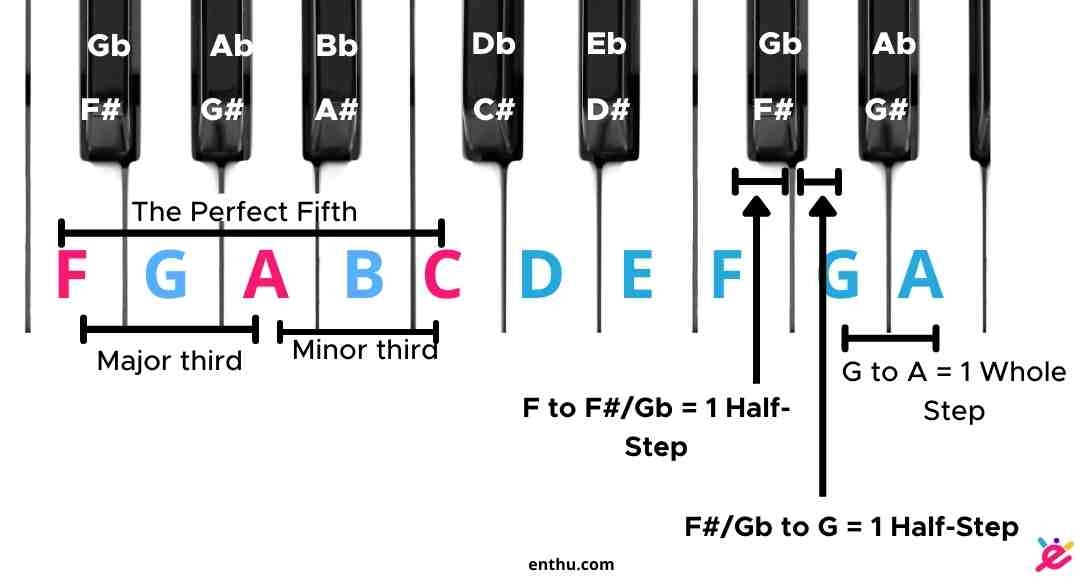
Intervals play a key role in how the sound of the chord will turn out to be. Intervals are measured in half-steps and whole-steps.
Half Step Whenever you read half-step
Whenever you read half-step, it means you have to move from the current key to the immediate left or right key. As shown in the above picture, the distance between F and F#/Gb is half-step. Similarly, the distance between F#/Gb and G is another half-step.
Whole Step Simply
two half steps combined is called a whole step. For example, the distance between F and G is a whole step. Keep in mind that a whole-step is made of two half-steps, just like in mathematics. So, if the instructor says two whole steps, it actually means 4 half-steps.
Simply, two half steps combined is called a whole step. For example, the distance between F and G is a whole step. Keep in mind that a whole-step is made of two half-steps, just like in mathematics. So, if the instructor says two whole steps, it actually means 4 half-steps.
Major Third/Common Interval A common interval is the distance of
A common interval is the distance of four half-steps or two whole-steps, also called the major third. The distance from F note to A note in the above picture is a major third. How?
F to F#/Gb : Half-step F#/Gb to G : Half-step G to G#/Ab : Half-step G#/Ab to A : Half-step In total there are four half-steps. So, it's a major third.
Minor Third The distance of
The distance of three half-steps or one and a half whole steps is called the minor third. Checkout the above image for reference. The distance between A and C notes is minor third.
A to A#/Bb : Half-step A#/Bb to B : Half-step B to C : Half-step In total there are three half-steps. So, it's a minor step.
Perfect Fifth The distance of
The distance of seven half-steps or four and a half whole steps is called the minor third. In the above picture, the distance between F and C notes is the perfect fifth. To understand it better, count the half-steps with me.
F to F#/Gb : Half-step F#/Gb to G : Half-step G to G#/Ab : Half-step G#/Ab to A : Half-step A to A#/Bb : Half-step A#/Bb to B : Half-step B to C : Half-step There are a total of 7 half-steps or 41/2 whole-steps.
How to Make Piano Chords?
Let's try to make Major piano chords and Minor piano chords, as they're the most common ones. Making here means drawing the chords for your own convenience.
1. Make Piano Major Chords
A major chord is made up of 3 notes, a triad. The intervals are very crucial in making of a triad.
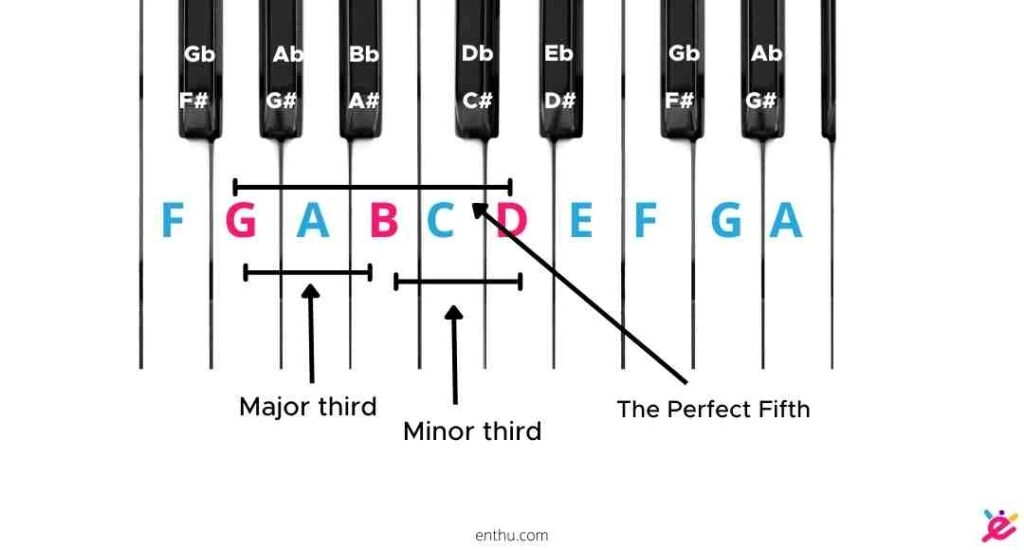
G Major Chord Take a look at the above picture to understand the making of a major chord on piano. It's the G Major Chord on piano in the above image. The interval between the root (G) and the third note (B) is a major third.
This interval is a common interval, which means it has four half-steps and two whole-steps. In other words, there are four half-steps from G to B. G to G#/Ab : Half-step G#/Ab to A : Half-step A to A#/Bb : Half-step A#/Bb to B : Half-step
The interval between the root note (G) and the fifth note (D) of the chord is a perfect fifth. As discussed above, a perfect fifth interval is made of 7 half-notes. And, the distance between the third note (B) and the fifth note (D) is a minor third, which is made of three half-steps.
2. Make Piano Minor Chords
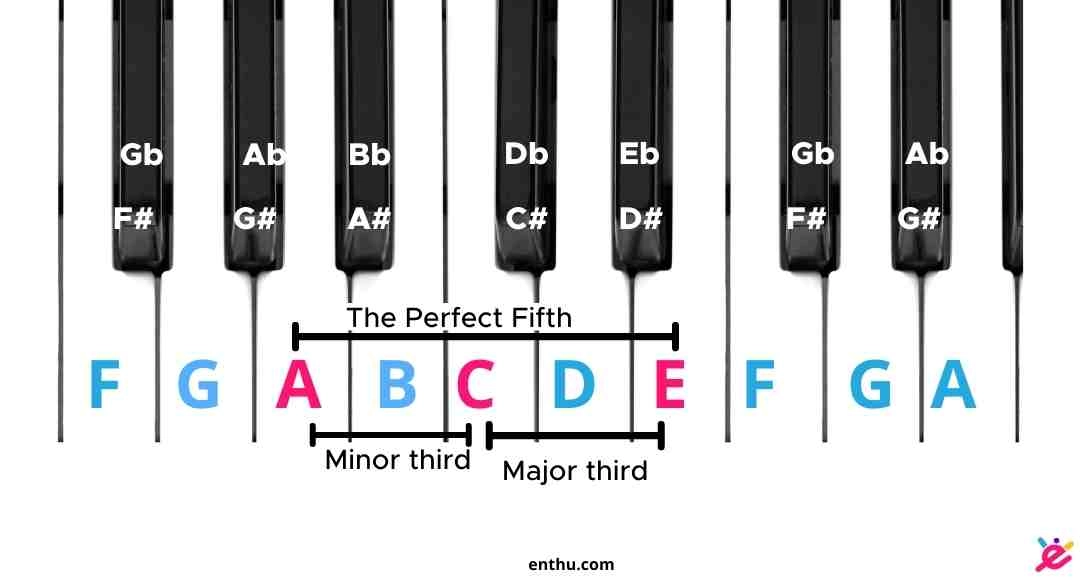
Like major chords, piano minor chords are also made of three notes. In minor chords, the interval between the root note and the third note is a minor third, and the distance between the third note and the fifth note is a major third.
And, the distance from the root note to the fifth note is called a perfect fifth. Check out the above image to see A minor chord on piano. To make minor chords on piano, please keep the intervals in mind. Learn more about 6/8 Time Signature
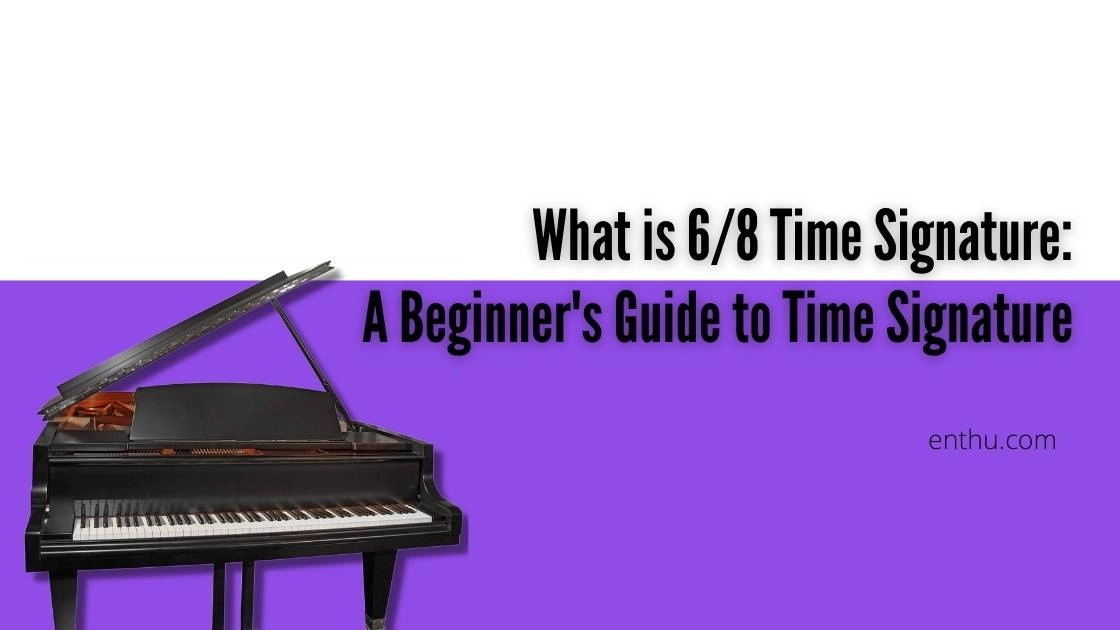
Different Types of Piano Chords
There are a total of 9 types of piano chords. Although many of these are seldom used, even by professional pianists, it won't hurt to learn a bit more. These 9 types are:
1. Major Chords
Major chords are the most prominent and are used the most. These are made of a root note, a major third, and a perfect fifth. Generally, major chords are considered happy chords. Example: A Major, C Major, D major, etc.
2. Minor Chords
Quite the opposite to the major chords, minor chords are considered as sad/serious/gloomy chords. Slightly different from major chords, minor ones consist of a root note, a minor third, and a perfect fifth. Example: F minor, G minor, E minor, etc.
3. Diminished Chords
As the name suggests, diminished chords give off an unpleasant or tense vibe. These chords are constructed with a root note, a minor third, and a flat/diminished fifth.
Example: C diminished chord (C – Eb – Gb).
4. Major Seventh Chords
Unlike the diminished chords, the major seventh chords sound serene and thoughtful. These chords are commonly used in Jazz piano. Major seventh chords consist of a root note, a major third, a perfect fifth, and a major seventh. These chords are like major chords, only with 7th on top. This is your first introduction to four-note chords. Example: C Major Seventh chord (C – E – G – B)
5. Minor Seventh Chords
Some pianists name these kinds of chords flaky or moody chords because they sound contemplative. Minor seventh chords are created with a root note, a minor third, a perfect 5th, and a minor 7th, just like a major seventh with minor 7th on top. Example: C Minor Seventh Chord (C – Eb – G – Bb).
6. Dominant Seventh Chord
Dominant seventh chords are commonly used in Blues and Jazz music. These chords resonate with restlessness and power. Nowadays, dominant seventh chords are heavily used in Hip Hop, EDM, and R&B music. Made of a root note, a major third, and a perfect fifth, the dominant seventh chord tops the sequence with a minor seventh chord. Example: C Dominant Seventh Chord (C – E – G – Bb).
7. Suspended
Chords (sus2 & sus4) Well, here's an entirely different set of chords. Suspended Chords go out of the traditional composition of a root, a third, and a fifth. There are two types of Suspended chords: Sus 2 chords and Sus4 chords. Examples: Csus2 (C – D – G) and Csus4 (C – F – G).
8. Augmented Chords
The eighth type of piano chord is called the augmented chord. These chords consist of a root note, a major third, an augmented fifth to top it off. Chill, you don't have to worry about these in your initial days. Example: C Augmented (C – F – G#).
9. Extended Chords
Jazz, Funk, and R&B music use these extended chords. The common types of extended chords are major Ninth Chords, Minor Ninth Chords, Dominant Ninth Chords, Major Eleventh Chords, and Minor Eleventh Chords.
Head spinning already? Don't worry; you don't even need to play the last 6 types of chords for a long time now. As you are just starting off, focus on the simple major and minor chords for the time being.
Piano Chord Progression
1. Now you may wonder, what will you do with these chords?
Here swoops in the piano chord progression. The piano chord progression is simply a combination of chords that are played together in sequential order. You can literally play any song with a specific piano chord progression.
It develops the music in a meaningful and harmonical way. Although there are numerous chord progressions, learning the common chord progressions will be enough for now.
1. The 12-Bar Blues Chord Progression
This is one of the basic piano chord progressions. The best thing is that it uses only three chords. You can play exciting songs like 'The Thrill is Gone' by B.B. King, 'Rock Around the Clock' by Bill Haley, or even 'Hound Dog' by Elvis Presley with the 12-bar blues chord progression. Isn't this mind-blowing?
2. The ‘Cadential’ Chord Progression
This is one of the most common piano chord progressions in the world. It defies the genre by submerging Gospel, Classical, and Jazz piano chords. You will jump out of your chair after reading this; you can actually play 'Tears in Heaven' by Eric Clapton and 'Tune Up' by Miles Davis with this chord progression.
3. The All-Purpose Progression
As the name suggests, this piano chord progression helps you in the process of songwriting. It has a tinge of a dramatic element to it, thanks to the minor vi chord. Boast in front of your friends by playing 'Let it Be' by The Beatles, 'Beast of Burden' by Rolling stones, or even 'I'm Going down' by Bruce Springsteen.
Some other famous piano chord progressions are the Classic 3-Chord Progression, the Canon (Pachelbel) Progression, the 50s Chord Progression, and the Andalusian Cadence.
This is enough information for you now. Do not take too much on your plate and practice what you've learned. Always remember that if you stick to the keyboard, it will surely reward you. If you are looking for piano classes online, come to EnthuZiastic and start living a musical life.


Conclusion
I can understand that it's too much information for you now. But don't get scared. Even the greats like Philip Glass and Lang Lang were beginners once, and I bet that they were as confused as you are now.You know, the key is to practice, and even the tiniest progress counts. Don't be hard on yourself; instead, go with the flow of music. Cheers to your amazing journey with the piano!
FAQs
1. What is a chord?
A chord is a combination of three or more notes or keys. Chords are usually constructed with a keynote, a third, and a fifth.
2. How many chords are there on the piano?
There are 12 major chords on the piano. If you want to play the major chords, consider the major notes as their keynote and play the immediate third and fifth with it. How do you name piano chords? Naming the piano chords is simple. All the chords are named after each chord's keynote. You just need to identify that, and you can automatically name the chord.


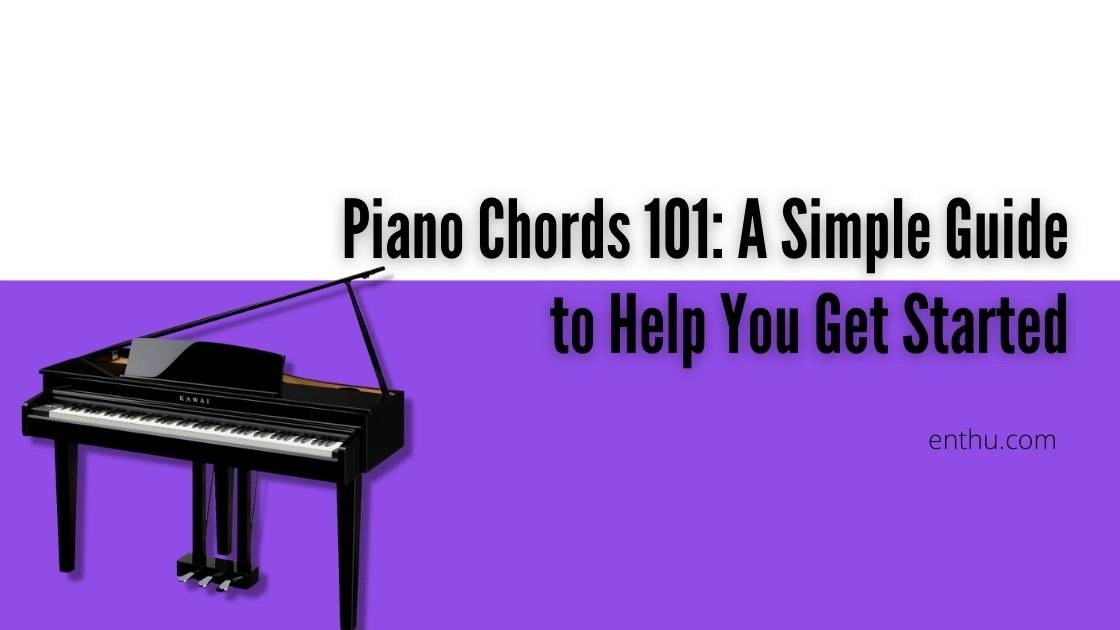
.png)


Comments